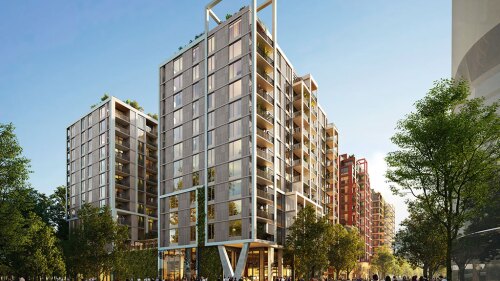Ten new civic buildings showcase design strategies that trim electricity bills.
As municipal and federal governments increasingly adopt green building standards, they raise the bar for their own civic structures. Given the strapped economy and a shrinking tax base, energy efficiency, among all sustainability measures, may have the most appeal, promising a big drop in operational costs over the long term. It also has synergy with other aspects of green design. For example, natural light and ventilation reduce the energy drain of artificial lighting and mechanical systems while also enhancing indoor environmental quality, and vegetated roofs not only soak up stormwater, but also provide excellent insulation.
The following ten public sector projects, all completed in the past five years, draw on a variety of architectural strategies—often leading-edge ones—to cut energy use. All employ passive strategies, ranging from smart building orientation and energy-modeled daylighting strategies to finely tuned approaches to natural ventilation. A number take advantage of the steady temperatures of the earth or bodies of water to moderate their temperatures in hot and cold weather. From a sustainability outreach center in the desert to a Canadian convention center built partly over a waterway, they demonstrate approaches applicable for both the public and private sectors. (The ten projects are listed alphabetically, not in any rank order.)
1. Desert Living Center - Las Vegas, Nevada
It is hard to imagine living in Las Vegas before air conditioning. But the Anasazi Indians managed the Mojave Desert climate by erecting thick-walled structures, oriented in relation to the sun to minimize solar heat gain. The Desert Living Center borrows this technique, with walls of rammed earth, straw bale, concrete, and earth berms providing thermal insulation. A complex of five buildings within the Las Vegas Springs Preserve, the Desert Living Center is the Las Vegas Valley Water District’s public outreach and applied research facility, intended to inspire residents to better adapt their lives to the desert environment.
To help beat the heat, the buildings include cool towers, which pull breezes across moistened pads to take advantage of evaporative cooling, plus shaded courtyards and roof overhangs. Exterior and interior light shelves bounce daylight deep into the interiors. Highly efficient mechanical systems, photovoltaics, solar water heating, lighting sensors, and radiant floor heating further shrink electricity bills. Designed by local firm Lucchesi Galati and certified Platinum under the U.S. Green Building Council’s Leadership in Energy and Environmental Design (LEED) rating system, the complex opened in 2007.
2. East Portland Community Center Aquatic Center Addition - Portland, Oregon
Natatoriums are energy hogs. Heating swimming pools draws a lot of power, as does the ventilation necessitated by chlorinated water. In designing the aquatic center addition to the East Portland Community Center in Oregon, local firm Sera Architects achieved the biggest energy savings by killing two birds with one stone: a heat recovery system warms the pool water with air exhaust from the facility.
To ensure optimal daylighting, the design team fine-tuned the size and placement of windows according to their location, assisted by the University of Oregon’s Energy Studies in Buildings Laboratory. Occupancy sensor–controlled light fixtures and strategically placed clerestories enable natural light alone to illuminate the space for an average of 60 percent of its operating hours. A photovoltaic array, a solar thermal array that preheats shower water, and an innovative filtration system further reduce energy requirements. Opened in 2009, it achieved a LEED Platinum rating.
3. Greensburg City Hall - Greensburg, Kansas
In 2007, a severe tornado destroyed almost all the buildings in Greensburg. Before the year was out, the city council adopted a resolution mandating that all city buildings larger than 4,000 square feet (370 sq m) be designed to achieve a LEED Platinum rating. The first of them, the new 4,800-square-foot (450-sq-m) city hall, opened in 2009.
Architecture firm BNIM of Kansas City, Missouri, gave the structure an insulated standing seam metal roof with a thin-film, 4.8-kilowatt photovoltaic system on south-facing surfaces that meets 11 percent of the building’s energy needs. A vegetated roof above the administration wing minimizes the heat-island effect. Insulated concrete forms clad with bricks reclaimed from the town’s destroyed power plant provide the building with thermal mass. Ground-source heat pumps, energy-efficient lighting, and reliance on natural light further cut electricity consumption. With the solar power plus energy from the recently completed Greensburg Wind Farm, the city hall is projected to use 44 percent less electricity than would a conventional counterpart.
4. Madison Fire Station No. 12 - Madison, Wisconsin
The far west side of Madison is a growing neighborhood of homes, businesses, and a mixed-use research campus now under construction. To meet the developing area’s needs, the city opened its newest fire station in 2009. Madison Fire Station No. 12 holds living, working, and sleeping quarters for six firefighters, a six-vehicle apparatus room, a command center, and a community room.
At an eco-charrette attended by city representatives, engineers, the commissioning authority, the construction manager, and the designer—local firm Plunkett Raysich Architects—the city set a goal of achieving significant energy savings. A ground-source heat pump system supplies cooling and heating. Sunshades and pergolas mitigate solar heat gain while solar hot water collectors provide the building’s hot water. Glazed doors and clerestory windows let natural light into the apparatus room. Overall, the fire station’s estimated energy use is 55 percent less than the average for the city’s 11 other fire stations.
5. Manassas Park Elementary School + Pre-Kindergarten - Manassas Park, Virginia
When the temperature and humidity are favorable, green lights come on in classrooms at Manassas Park Elementary School + Pre-Kindergarten, signaling to students that windows can be opened; the mechanical system shuts down while natural convection currents continue to circulate air. This is just one of several ways the city’s new educational facility engages students in learning about sustainability.
Designed by VMDO Architects of Charlottesville, Virginia, and completed in 2009, the building leverages natural light with extensive glazing. South-facing classrooms are protected by shading structures as well as light louvers angled to bounce daylight off strategically sloped ceilings that protect the teaching walls from glare. Photosensors and occupancy sensors dim and turn off lights as necessary. Roof monitors bring in light from the north; 89 tubular skylights bring daylight into interior areas; mirrors in corridors add brightness. Closed-loop geothermal wells provide heating and cooling.
6. Manchester Civil Justice Centre - Manchester, U.K.
The design brief for the new civil justice center in Manchester requested a building that relied as much as possible on natural ventilation, natural light, and passive energy strategies. Through a public/private partnership with London developer Allied Properties, the government achieved its intention. Completed in 2007 and designed by the London office of Denton Corker Marshall, the built result also embodies openness and accessibility.
To make the most of natural light and air, the design team gave the building a narrow form, stacking it 15 stories high. Although it has a mechanical heating and cooling system, natural ventilation suffices for most of the year, with wind scoops bringing outside air into ducts and under-floor plenums. A light/air duct and light shelves bring daylight deep into the interior. The discovery of a large aquifer beneath the site enabled use of groundwater cooling to supplement the system’s chillers. The veiled eastern facade lets in daylight but blocks solar heat gain and provides visual privacy. The facility has received an Excellent rating under the Building Research Establishment Environmental Assessment Method (BREEAM) system.
7. Scottsdale Fire Station No. 2 - Scottsdale, Arizona
At the LEED Platinum–certified Fire Station No. 2 in Scottsdale, the communications/training tower doubles as a cooling tower, passively expelling heat from the exterior courtyard and community meeting room to reduce the need for air conditioning in summer months. Completed in 2008, the building is oriented so that the long sides face north and south, mitigating exposure to the hot western sun. Large roof overhangs shade the southern facade. During the winter, the south-facing steel standing seam metal roof passively heats the three apparatus bays.
Other strategies include insulated low-emissivity windows, high levels of insulation, energy-efficient mechanical equipment, lighting equipped with motion sensors, photovoltaic panels, and solar hot water collectors, which provide 95 percent of all the building’s hot water, as well as some space heating. Ninety-five percent of the occupied spaces are placed along the building’s perimeter, maximizing natural light. LEA-Architects LLC of Phoenix designed the facility.
8. Surry Hills Library and Community Centre -Sydney, Australia
Located in a dense suburb of Sydney, the Surry Hills Library and Community Centre uses its atrium as lungs, achieving both energy efficiency and high indoor air quality. The glazed atrium’s triangular shafts draw outside air at the building’s roof, where the air is freshest.
After being filtered through carefully selected plants, the air travels through a basement-level thermal labyrinth that moderates its temperature before sending it back into the atrium and the building’s air ducts. This strategy greatly reduced the size of the mechanical system needed, as well as the energy used for air conditioning.
The four-level library and community facility, which includes a child care center, also saves power with extensive use of natural light, automatic fabric shading, a front facade equipped with daylight-tracking louvers, a vegetated roof, and rooftop photovoltaic panels. A building management system controls the building’s lighting, ventilation, and shading in response to changes in climate over the course of each day. Sydney-based Francis-Jones Morehen Thorp designed the building, which opened in 2009.
9. Vancouver Convention Centre West - Vancouver, British Columbia
The sea is key to Vancouver Convention Centre West’s energy efficiency. Located on a former brownfield site along the city’s primary marine waterway, the facility extends over more than eight acres (3 ha) of water. The design team—Seattle-based LMN Architects and local firms Musson Cattell Mackey Partnership and DA Architects + Partners—consulted with marine biologists to make the perimeter foundation system double as an artificial reef to help restore the shoreline.
The convention center has an integrated seawater heat pump system, employing the constant temperature of the seawater to heat and cool the building via radiant flooring in most of the program spaces. A steam plant provides backup for heating. In addition, the structural glass curtainwall on all sides allows plenty of natural light into public spaces while visually connecting the facility to the city. A six-acre (2-ha) vegetated green roof serves as insulation and a wildlife habitat. Owned by the provincial government’s BC Pavilion Corporation, the convention center was completed in 2009 and has received a LEED Platinum rating.
10. Whistler Public Library - Whistler, British Columbia
Most of the buildings in the resort town of Whistler resemble chalets, with steeply pitched roofs designed to shed the winter’s heavy snows—but not the new public library. Its vegetated roof is designed to hold most of the snow, making use of its insulating properties. The roof—made of locally sourced hemlock—slopes gently upward at the northern facade, which has a high-performance curtainwall system that maximizes natural light for the reading areas. Deep roof overhangs shield the southern and eastern facades from the sun’s heat.
A ground-source heat exchange system meets about 70 percent of the building’s heating and cooling needs and is supplemented by high-efficiency natural gas–fired boilers as required. Displacement heating and cooling is delivered through a raised floor, and operable windows facilitate natural ventilation. Designed by Vancouver firm Hughes Condon Marler Architects, the facility opened in 2008 and has received a LEED Gold rating.















